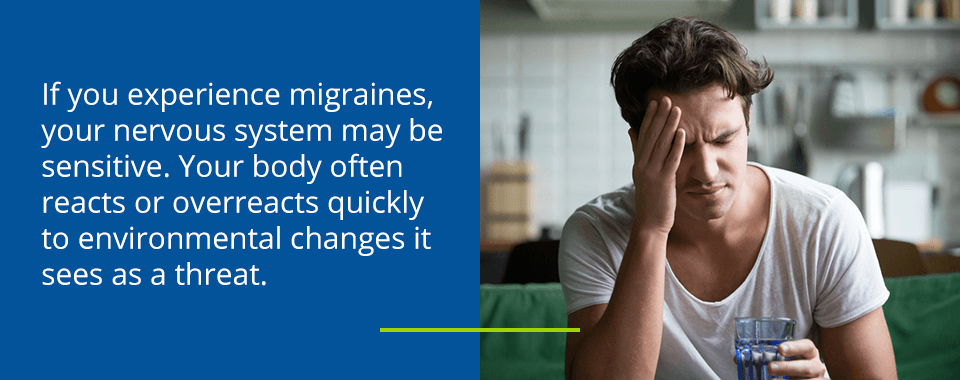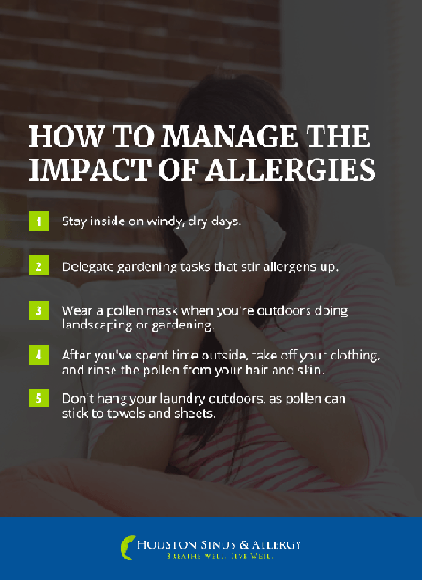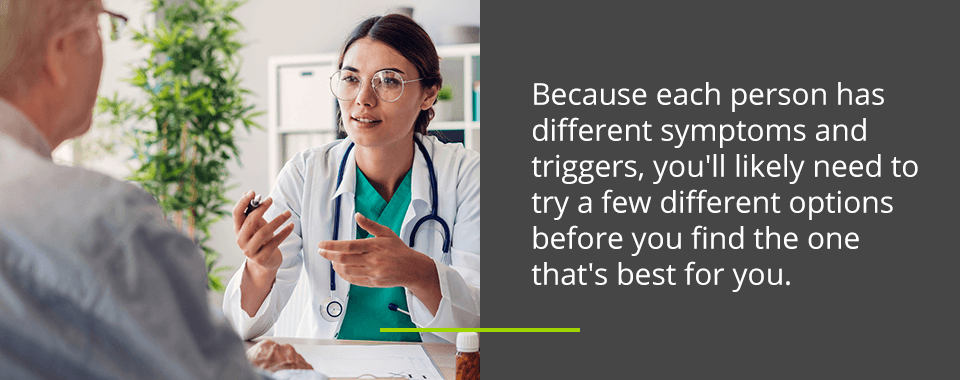
Chirping birds aren’t the only thing you hear in Houston. You may also hear a lot of coughing and sneezing from allergy sufferers. Spring allergies symptoms in Houston are common. From weeds blooming to trees flowering, the ecosystem in Houston is very active and has plenty of pollen. Itchy throats and runny noses are the consequences of your body responding to nature, and it seems it’s always that time of year.
Allergies are the sixth top cause of persistent illness in America, and over 50 million individuals suffer each year with allergies in the U.S. While some people have enduring allergies lasting throughout the year, others have seasonal allergies in the spring, summer or fall.
To help those suffering from allergies, we put together a guide to help you understand why allergies occur, the symptoms you may experience and what you can do to manage them.
Why Allergies Occur
Spring allergies generally begin in March, when the trees start to blossom and weeds grow, though the timing can vary. For instance, you might notice some years your allergies seem worse than others, or they peak earlier or later in the spring season.
Pollen is the biggest trigger of spring allergies. Grasses, weeds and trees release tiny grains throughout the air that fertilize other plants. If you have allergies and those grains get inside your nose, they cause your body’s defenses to go haywire. Your immune system mistakes the pollen for something harmful and releases antibodies to attack the allergens, leading to the release of histamines into your blood. The histamines trigger your allergy symptoms.
Some trees that trigger allergies are:
- Ash
- Alder
- Beech
- Cedar
- Cypress
- Elm
- Maple
- Olive
- Pine
- Willow
Some weeds and grasses that trigger allergies are:
- Bermuda
- June
- Orchard
- Redtop
- Saltgrass
- Timothy
Pollen also travels for miles, so your allergies might not only be caused by plants in your neighborhood. On breezy days when the wind collects grains and carries them through the air, pollen counts are especially high. Alternatively, on rainy days, the allergens get washed away.
Symptoms of Spring Allergies
The degree and quantity of allergens in the environment and air, as well as your immunity, determine the severity of your spring allergy symptoms. If the amount of air allergens is high, you’ll likely deal with more severe allergies in spring.
Likewise, if you are currently sick or previously had a sickness that depleted your immune system, spring allergy triggers and antigens are more likely to affect you. Some symptoms of spring allergies include the following.
Headache
Spring allergies can lead to headaches. Sinus headaches and migraines are often confused because they share many of the same symptoms, such as:
- Intense sinus pressure
- Pounding headache
- Stuffy nose
But how do spring allergies cause migraines? The association is complex. Physicians are still trying to find this answer. Presently, they know your immune system, hormones and nervous system all play a role.

If you experience migraines, your nervous system may be sensitive. Your body often reacts or overreacts quickly to environmental changes it sees as a threat. Also, allergen exposure triggers your immune system to release specific chemicals that can feed inflammation and cause a migraine.
Sore Throat
As a child, you likely experienced sore throats that were fixed by sucking on a throat lozenge. But now, no matter how you treat it, your sore throat persists for days or weeks. If this is the case, it’s a good indication your spring allergies are causing the sore throat.
When your throat is sore and irritated due to an allergic reaction to allergens like pollen, it calls for a more complicated treatment. Addressing the exact cause of your allergies could help you ease your sore throat for good.
One primary culprit of allergy-induced sore throat is a postnasal drip. It’s due to allergen exposure and occurs when you have sinus congestion that drains down your throat, causing scratchy and tickling pain. This drainage can also cause:
- Excessive swallowing
- Coughing
- Difficulty speaking
- Throat irritation
Many allergies are seasonal, like pollen allergies. But if you’re experiencing symptoms year-round, they can become worse during seasons with high airborne irritants like trees and pollinating flowers during the spring.
Sneezing
We all sneeze. But, when is sneezing due to allergies? Sneezing can occur when you least expect it, like when you step outside into the sunlight or pluck your eyebrows. Sneezes can even occur when your eye’s nerves become exposed to bright light.
Hay fever, or allergic rhinitis, is a term that describes allergic nose reactions and can lead to sneezing. Individuals suffering from symptoms of nasal allergy don’t necessarily share the same triggers.
For instance, if you have spring allergies, you may be allergic to grass pollen or a specific tree that only causes you to sneeze, and you may experience other symptoms at other times of the year. Or you may have an allergy to a certain type of mold that shows up in the fall when it rains and the leaves are wet. Over two-thirds of individuals suffering from seasonal allergies also experience year-round symptoms.
Cough
If you’re experiencing a chronic dry cough, it could be a symptom of asthma or allergies. If the cough is allergy-related, you may notice you cough more in specific environments or during particular seasons. Hay fever can also cause you to cough.
Watery Eyes
The same irritants that make you sneeze or give you a runny nose also cause allergic reactions in your eyes. Watery, itchy and red eyes are common symptoms of spring allergies. Your best approach for managing eye allergy symptoms is to limit your exposure to the allergens you’re most sensitive to.
Stay indoors as much as you can on days with a high pollen count. Make sure you’re running your air conditioner to filter the air and using high-quality filters to trap the allergens. For the best results, be sure to replace the filters regularly.
Fatigue
Fatigue isn’t always an obvious symptom of spring allergies. Of course, some allergic reactions make you tired, but the true cause of your allergy-related fatigue relates to your breathing.
If you’re dealing with a flare-up, chances are your nasal passages are becoming a bit too tight. In the daytime, this can lead to poor breathing, leaving you dashing for the medicine cabinet. During the nighttime, however, breathing is much more important.
As you sleep, all your throat muscles loosen up and make your airways smaller. When you’re congested, it could cause an issue similar to sleep apnea. While you won’t wake up dozens of times during the night like a person with sleep apnea, you won’t sleep like a baby, either.
Another reason you feel fatigued has to do with the treatment rather than the problem. Antihistamines can cause drowsiness, and if you start becoming reliant on them, you begin noticing you feel tired all the time.
Congestion
Congestion is another symptom of seasonal allergies that can impact your sensory perception. It occurs when the membrane in your nasal passage becomes inflamed, narrowing your nasal passages and making it harder to breathe. Because your sense of smell is impacted, it will change your sense of taste. If your ears are affected by nasal congestion, you may find they feel like they’re “blocked.”
Spring allergies could cause your nasal congestion. Your immune system sees pollen as a threatening virus and tries to trap the virus by producing excess mucus, triggering an allergic reaction and your nasal congestion.
Postnasal Drip
In some cases, along with sneezing and watery eyes, allergies can cause postnasal drip, meaning mucus drains down the back of your throat. In some cases, you can develop allergic rhinitis or hay fever, which will inflame your nasal airways from inhaling an allergen like dust or pollen. Postnasal drip can be mild to severe.
How to Manage The Impact of Allergies

Spring seasonal allergies can make you miserable. Try these strategies to help manage the impact of your allergies.
Decrease Your Allergy Trigger Exposure
To decrease your exposure to things that often trigger your allergies, you should:
- Stay inside on windy, dry days.
- Delegate things like weed pulling, lawn mowing and other gardening tasks that stir allergens up.
- Wear a pollen mask when you’re outdoors doing landscaping or gardening.
- After you’ve spent time outside, take off your clothing, and rinse the pollen from your hair and skin with a shower, especially before going to bed.
- Don’t hang your laundry outdoors, as pollen can stick to towels and sheets.
Keep Indoor Air Clean
You can’t eliminate all allergens from your home, but you can make an impact by:
- Using the air conditioning in your car and home.
- Running a dehumidifier to keep indoor air dry.
- Keeping your windows closed on high pollen days.
- Employing high-efficiency filters with forced air conditioning and heat, and following routine maintenance schedules.
- Buying a portable HEPA, or high-efficiency particulate air filter, to run in your bedroom or other areas where you spend a considerable amount of time.
- Cleaning your floors frequently with a vacuum cleaner.
- Replacing carpeting with hardwood, tile or laminate flooring.
Try an OTC Remedy
There are a few types of over-the-counter medications you can try to ease your allergy symptoms, including:
- Decongestants
- Oral antihistamines
- Nasal spray
- Combination medications, like combining a decongestant with an antihistamine
Rinse Your Sinuses
Use a saline solution to rinse your nasal passages. It’s an inexpensive, quick and effective way of relieving nasal congestion, flushing the allergens and mucus from your nose.
Use a neti pot — a small plastic or ceramic container with a spout that rinses out the nasal passages — or a squeeze bottle. Some people find nasal allergy symptom relief without having to take medications by using a neti pot. You can find both saline solutions and neti pots at your health food store, pharmacy or online.
Spring Allergy Treatments

There are many treatments available to allergy sufferers. Because each person has different symptoms and triggers, you’ll likely need to try a few different options before you find the one that’s best for you. Some common allergy treatments include the following.
Allergy Testing (Skin Testing/RAST)
Allergy testing greatly increases your standard of living. Knowing your allergy triggers can help you avoid them and can direct you toward a treatment that could blunt the impact of your allergies.
Allergy testing involves testing the blood or skin to determine which allergens trigger your allergic reaction. There are a few types of skin tests:
- Skin Prick Test: The doctor places a drop of solution that contains a potential allergen on your skin, and a series of needle pricks or scratches helps the solution get into your skin. If your skin develops a raised, red itchy area, it typically means you are allergic to this allergen.
- Intradermal Test: The doctor injects a small amount of the allergen mixture into your skin. They may perform an intradermal allergy test when a substance doesn’t cause a reaction during the skin prick testing, but they still suspect you are allergic to it.
- Skin Patch Test: The doctor places the allergen solution on a pad they tape to your skin for 24 to 72 hours. It helps detect a skin allergy known as contact dermatitis.
Immunology, or Shots/Sublingual Immunotherapy
Allergy shots are an effective treatment, particularly if:
- You can’t avoid the allergens, and allergy medicines don’t keep your symptoms under control.
- You would like to decrease your long-term use of allergy medicine.
- You have troublesome interactions or side effects from allergy medicines.
Sublingual immunotherapy works much like allergy shots, but it’s given sublingually — under your tongue — rather than through an injection. You can take the drops at home instead of going to your doctor’s office every week to receive an allergy injection.
Turbinate Reduction
Turbinate reduction is a procedure to reduce the size of the turbinates, which are small internal nose areas that help to humidify and cleanse the air you breathe. The procedure can have lasting benefits by allowing for more airflow, resulting in symptomatic nasal congestion and obstruction relief. This will make it easier to breathe and can eliminate the nasal drip and stuffy feeling you get with allergies.
Book an Assessment With Houston Sinus & Allergy to Get Relief From Your Allergies
As allergy and sinus doctors, Houston Sinus & Allergy specializes in ear, nose and throat ailments. We provide various quick and natural treatments to give you a full spectrum of relief. Contact us or visit our website to book an assessment and get the relief you seek from your allergies.

